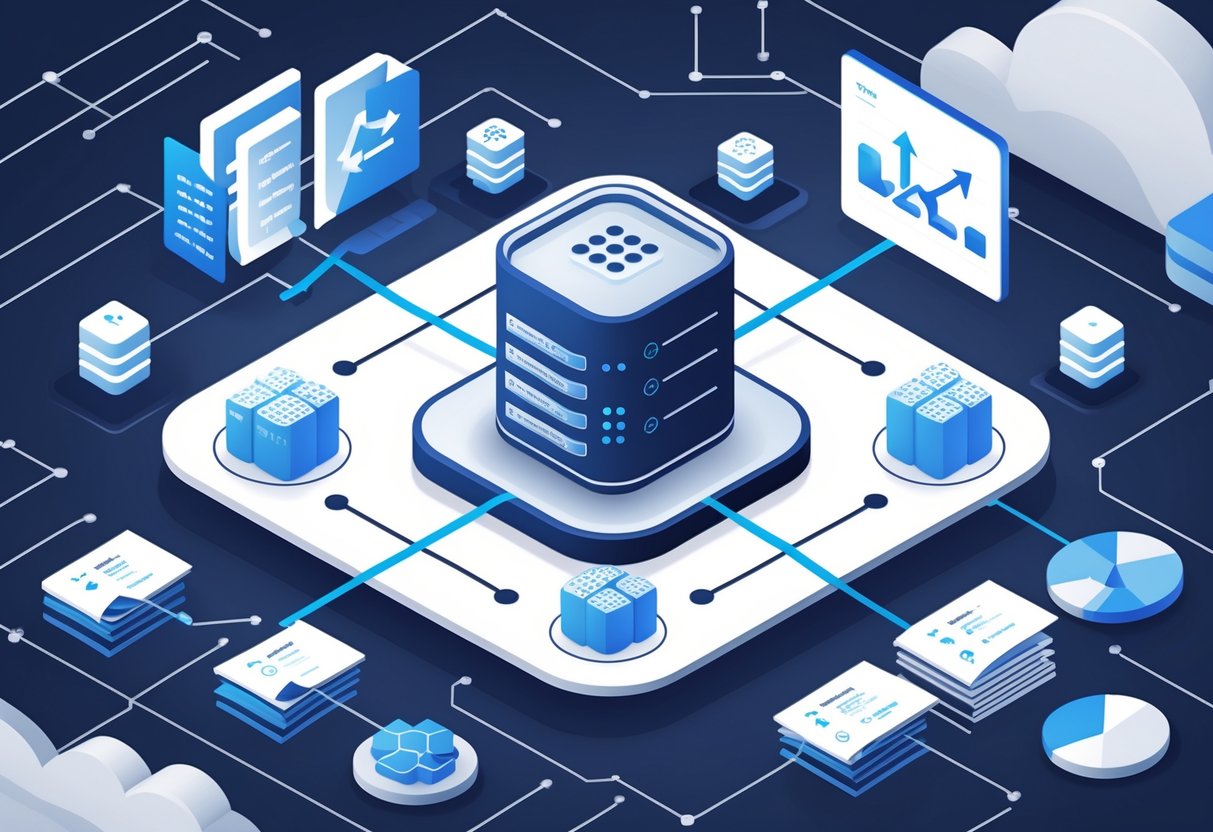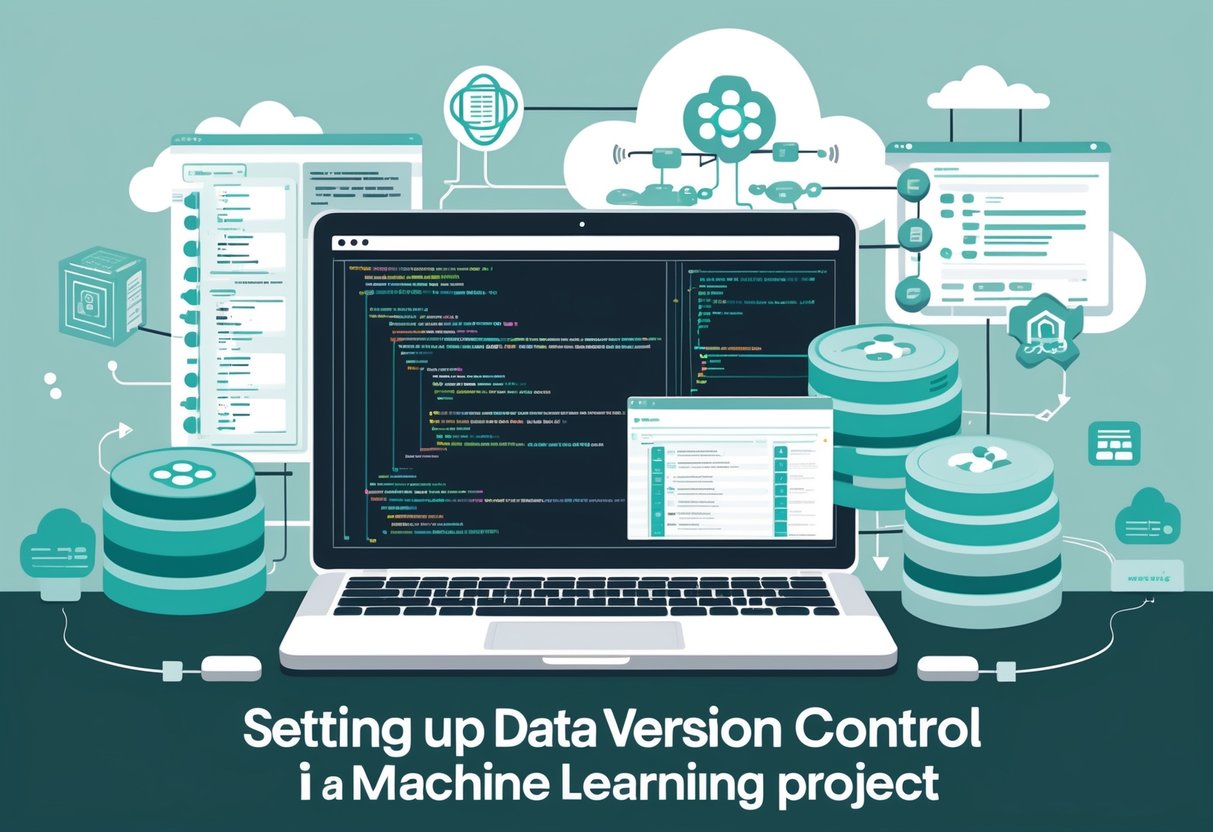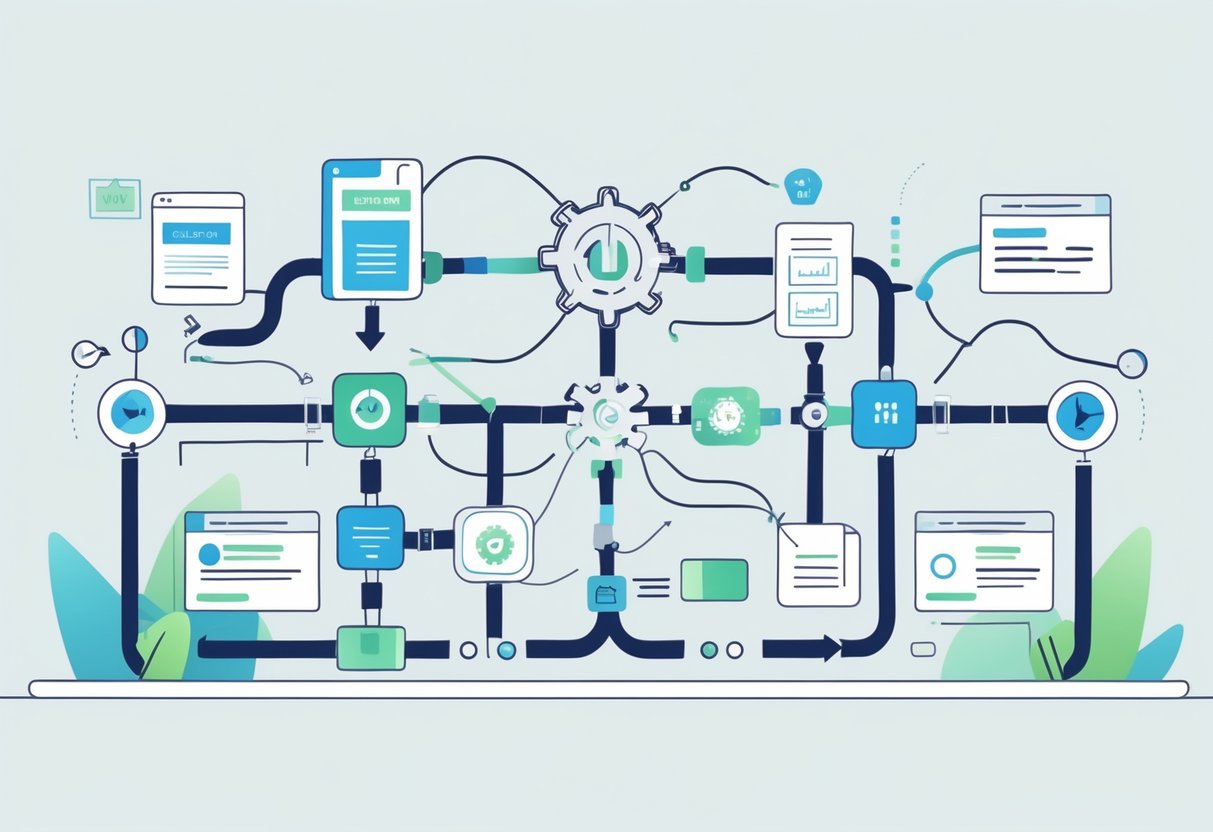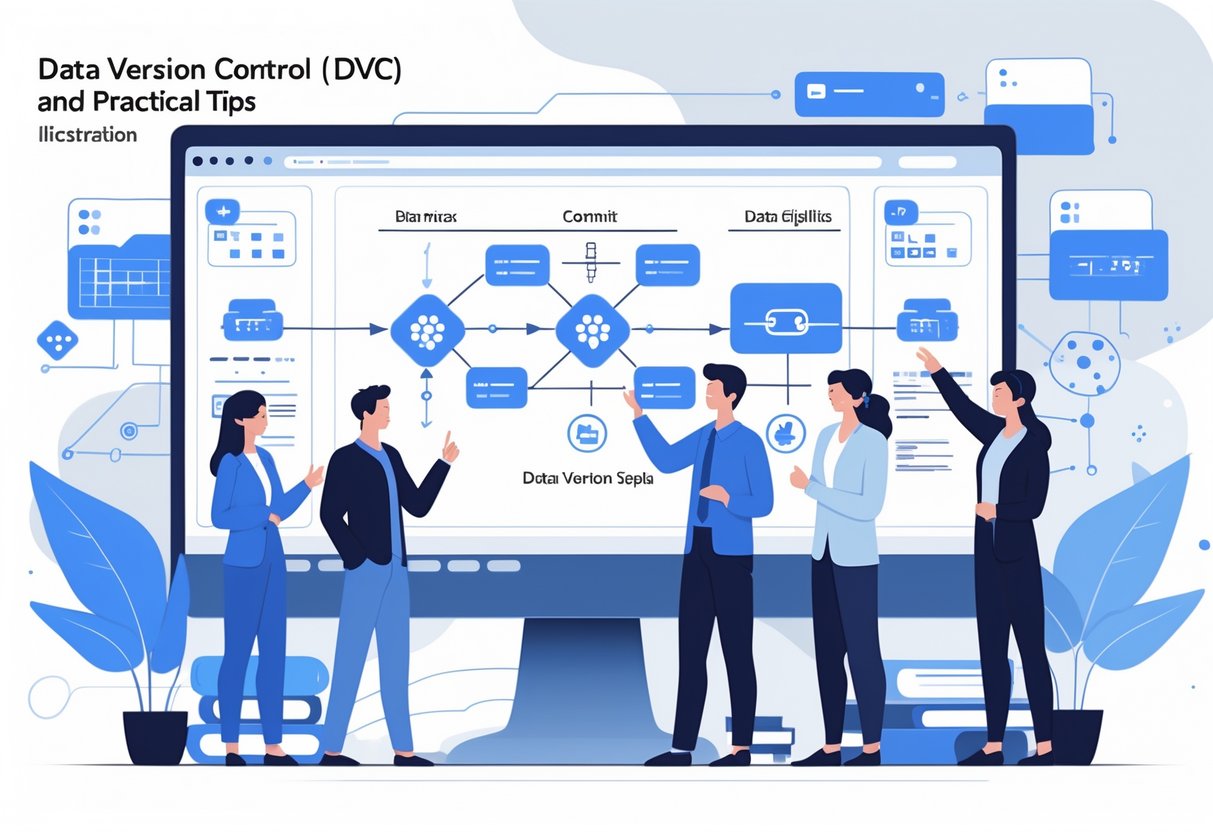Managing large datasets and machine learning models in version control has always been a challenge for data scientists. Traditional tools like Git work well for code but struggle with the massive files common in data science projects. Data Version Control (DVC) solves this problem by providing Git-like functionality specifically designed for tracking datasets, models, and machine learning experiments.

DVC acts as a bridge between Git and data storage systems, allowing teams to version their data without storing massive files directly in Git repositories. It creates lightweight metadata files that Git can track while keeping the actual data in separate storage locations. This approach enables data scientists to switch between different versions of datasets instantly and collaborate more effectively on machine learning projects.
This guide covers everything from basic DVC concepts to advanced workflow automation. Readers will learn how to set up DVC in their projects, create reproducible pipelines, and implement best practices for team collaboration. The article also addresses common questions and provides practical tips for integrating DVC into existing machine learning workflows.
Key Takeaways
- DVC enables Git-like version control for large datasets and machine learning models without storing files directly in Git repositories
- Teams can create automated pipelines and collaborate effectively using DVC’s remote storage and tracking capabilities
- Setting up DVC requires simple initialization commands and works seamlessly with existing Git workflows
Understanding Data Version Control and DVC

Data version control tracks changes to datasets and models over time, while DVC provides a Git-like system specifically designed for machine learning projects. This approach solves critical challenges like managing large files, ensuring reproducible experiments, and enabling effective team collaboration in data science workflows.
What Is Data Version Control?
Data version control treats datasets and machine learning models as important project assets alongside source code. Unlike traditional version control systems that work well with text files, data version control handles large files that change frequently in data science projects.
This system tracks different versions of datasets. It records when data changes, who made the changes, and what the changes were. Teams can go back to earlier versions of their data if needed.
Key benefits include:
- Tracking dataset changes over time
- Storing multiple versions without duplicating large files
- Comparing different data versions
- Restoring previous dataset states
Data scientists often work with files that are too big for regular Git repositories. Data version control systems handle these large files by storing them separately while keeping track of their versions.
How DVC Extends Traditional Version Control
DVC builds upon Git by introducing data versioning concepts for large files that should not be stored directly in Git repositories. It uses Git to track small metadata files while storing actual data in separate locations.
DVC creates special files called .dvc files and dvc.yaml files. These files act as placeholders that Git can track. The real data stays in a cache outside of Git.
DVC provides Git-like commands:
dvc init– starts a new DVC projectdvc add– tracks data filesdvc push– uploads data to remote storagedvc checkout– switches between data versions
The system works with existing tools teams already know. It supports cloud storage like Amazon S3, Google Cloud Storage, and SSH servers. No special servers or databases are required.
DVC does not replace Git. Instead, it works with Git to provide complete project versioning. Code goes in Git, while data and models get managed by DVC.
Key Challenges DVC Addresses in ML and Data Science
Machine learning projects face unique problems that traditional version control cannot solve. DVC addresses these specific challenges by providing tools designed for data science workflows.
Large file management becomes simple with DVC. Git struggles with files over 100MB, but DVC handles datasets of any size. It stores large files efficiently without slowing down Git operations.
Experiment reproducibility improves when teams can recreate exact conditions from past experiments. DVC tracks data versions, model parameters, and pipeline configurations together.
Team collaboration works better when everyone can access the same data versions. DVC provides centralized data storage that team members can share safely.
Pipeline automation gets easier with DVC’s ability to define and run multi-step processes. Teams can create workflows that automatically update when input data changes.
The system also handles storage costs by avoiding data duplication. Multiple experiments can share common datasets without creating extra copies.
Core Features and Concepts of DVC

DVC handles large datasets by storing them outside Git repositories while maintaining version control through metadata files. The system creates reproducible workflows by tracking data changes and pipeline dependencies alongside code versioning.
How DVC Handles Large Data Files
DVC solves the problem of managing large datasets that cannot fit in traditional Git repositories. Instead of storing actual data files in Git, DVC creates small metadata files that act as placeholders.
When users run dvc add on a large file, DVC moves the file to a cache directory. It then creates a .dvc file containing the file’s hash and metadata. This .dvc file gets committed to Git instead of the actual data.
The system stores large data files in remote storage locations like Amazon S3, Google Cloud Storage, or local servers. Users can access different versions of their datasets without downloading all versions locally.
Key benefits of DVC’s approach:
- No size limits on data files
- Fast Git operations
- Efficient storage usage
- Support for various cloud providers
DVC uses hardlinks or reflinks when possible to avoid copying files unnecessarily. This makes operations faster and saves disk space on local machines.
Data Versioning and Reproducibility
DVC creates reproducible machine learning workflows by tracking every component of a project. It records exact versions of data, code, and model parameters used in each experiment.
The tool generates pipeline files that define dependencies between different stages. When data or code changes, DVC identifies which pipeline stages need to run again. This prevents unnecessary recomputation of unchanged components.
DVC tracks these elements:
- Input datasets and their versions
- Processing scripts and parameters
- Output models and metrics
- Dependencies between pipeline stages
Each experiment creates a unique fingerprint based on input data and parameters. Teams can reproduce exact results by checking out specific commits and running dvc repro.
DVC stores metrics and parameters in human-readable files. This makes it easy to compare different experiments and understand what changed between versions.
Integration with Git Repositories
DVC works alongside Git to provide complete project versioning. While Git handles source code, DVC manages data and model versioning through metadata files stored in the Git repository.
Users follow familiar Git workflows like branching, merging, and pull requests. Each branch can contain different versions of datasets or experiments. Teams collaborate by sharing .dvc files through Git while storing actual data in shared remote storage.
DVC provides Git-like commands such as dvc checkout, dvc push, and dvc pull. These commands synchronize data files with their corresponding Git commits.
Unlike Git LFS, DVC offers:
- No special server requirements
- Support for any cloud storage
- Built-in ML pipeline features
- No repository size restrictions
The integration allows teams to version entire ML projects including code, data, and configurations. Developers can switch between experiments by simply changing Git branches and running dvc checkout.
Setting Up DVC in a Machine Learning Project

Setting up DVC requires initializing it within an existing Git repository and configuring it to track datasets and models. The process involves connecting DVC to Git, adding data files to version control, and establishing workflows for managing different versions of data and machine learning models.
Initializing DVC and Connecting to Git
DVC works as a layer on top of Git, so developers must have an existing Git repository before they can initialize a DVC project. The setup process begins by running dvc init inside the Git project directory.
When developers run dvc init, DVC creates several internal files including .dvc/config and .dvc/.gitignore. These files must be committed to Git to complete the initialization process.
The basic setup commands are:
git init(if starting a new project)dvc initgit add .dvc/config .dvc/.gitignoregit commit -m "Initialize DVC"
DVC integrates with Git by storing metadata about tracked files in special .dvc files. These small text files contain information about the actual data files while the original data gets added to .gitignore.
Adding and Tracking Data with DVC
The dvc add command starts tracking datasets and machine learning models in data science projects. When developers run dvc add on a file, DVC moves the original data to its cache and creates a corresponding .dvc metadata file.
For example, adding a dataset involves:
dvc add data/dataset.csvgit add data/dataset.csv.dvc data/.gitignoregit commit -m "Add dataset"
Key differences from Git:
| Git | DVC |
|---|---|
| Tracks code files directly | Tracks data through metadata files |
| Stores content in repository | Stores content in separate cache |
| Works with small files | Optimized for large datasets |
DVC automatically handles large files by storing them in .dvc/cache and linking them back to the workspace. The hash-based storage system ensures data integrity and enables efficient versioning.
Machine learning projects often contain multiple data files, models, and intermediate outputs. Developers can track entire directories with dvc add data/ to manage complex project structures.
Managing Data and Model Versions
DVC enables switching between different versions of datasets and machine learning models using Git workflow commands. Developers use git checkout followed by dvc checkout to sync data versions with code versions.
The typical versioning workflow includes:
- Modify data or retrain models
- Run
dvc addto track changes - Execute
git committo save metadata - Use
dvc pushto upload to remote storage
When collaborating on machine learning projects, team members retrieve data versions with dvc pull after running git pull. This ensures everyone works with the correct dataset versions that match the code.
Version switching commands:
git checkout <branch-or-commit>dvc checkout
DVC maintains separate storage for each data version, allowing developers to quickly switch between different datasets or model versions. The system tracks changes through content hashes, making it easy to identify when data has been modified and needs to be committed to version control.
DVC Pipelines and Workflow Automation

DVC transforms machine learning workflows through automated pipelines that track experiments and manage model parameters. Teams can build reproducible ML systems that handle everything from data processing to model evaluation with complete version control.
Building Machine Learning Pipelines with dvc.yaml
The dvc.yaml file serves as the central configuration for DVC data pipelines. This file defines each stage of the machine learning pipeline, from data preparation to model deployment.
Each pipeline stage includes specific components:
- cmd: The command to execute
- deps: Input dependencies like data files or scripts
- outs: Output files generated by the stage
- params: Configuration parameters used in the stage
stages:
train:
cmd: python train.py
deps:
- data/processed
- train.py
outs:
- models/model.pkl
params:
- learning_rate
- epochs
Pipeline stages run automatically when dependencies change. DVC tracks file checksums and rebuilds only the necessary parts of the pipeline.
Teams can create complex machine learning pipelines with multiple interconnected stages. Each stage builds on previous outputs, creating a clear workflow from raw data to final models.
Experiment Tracking and Management
DVC provides built-in experiment tracking that captures every aspect of model training runs. The system automatically records code versions, data snapshots, and hyperparameters for each experiment.
Researchers can compare experiments using simple commands:
dvc exp show
dvc exp diff experiment1 experiment2
The experiment tracking system stores results in a structured format. Teams can view metrics, parameters, and outputs across multiple runs without manual record-keeping.
Experiment management becomes systematic rather than chaotic. Data scientists can branch experiments like Git commits, testing different approaches while maintaining full history.
DVC integrates with CI/CD systems for automated experiment runs. Teams can trigger experiments on code changes, ensuring consistent testing across development cycles.
Utilizing Metrics and Parameters
Parameters and metrics form the foundation of reproducible machine learning experiments. DVC separates these concerns, making it easy to track what changes between runs.
Parameters live in YAML files and control model behavior:
- Learning rates
- Batch sizes
- Network architectures
- Data preprocessing settings
Metrics capture model performance and are stored in JSON format:
- Accuracy scores
- Loss values
- Validation metrics
- Custom business metrics
DVC automatically tracks parameter changes and links them to resulting metrics. This connection helps teams understand which hyperparameters produce the best results.
The system supports both scalar and nested parameter structures. Complex configurations remain organized and version-controlled alongside the code that uses them.
Teams can plot metrics over time or compare across experiments. This visualization helps identify trends and optimal parameter combinations for production models.
Collaboration and Remote Storage with DVC

DVC remotes provide access to external storage locations to share data and ML models across teams and devices. Remote storage enables data scientists to synchronize large datasets, collaborate effectively, and avoid regenerating artifacts locally.
Configuring and Using Remote Storage
Setting up remote storage begins with the dvc remote add command. This command connects DVC to various storage platforms including AWS S3, Google Cloud Storage, and Google Drive.
The basic syntax creates a remote connection:
dvc remote add myremote s3://mybucket
DVC supports multiple cloud providers and storage types:
Cloud Storage Options:
- Amazon S3 and S3-compatible services
- Google Cloud Storage
- Microsoft Azure Blob Storage
- Google Drive
- Aliyun OSS
Self-hosted Options:
- SSH and SFTP
- HDFS and WebHDFS
- HTTP and WebDAV
DVC reads existing cloud provider configurations automatically. This means many setups only require the basic dvc remote add command.
Additional configuration uses dvc remote modify for authentication and connection settings. The --local flag keeps sensitive credentials in a Git-ignored config file.
Collaboration Across Teams
Teams can easily share datasets and models via remote storage systems while ensuring everyone works with the same data versions. Remote storage acts as a central hub for data collaboration.
Data scientists can download artifacts created by colleagues without spending time regenerating them locally. This saves computational resources and speeds up project workflows.
DVC ensures synchronization across team members by providing consistent access to versioned data. Team members pull data directly from remote storage locations.
The collaboration workflow mirrors Git’s approach. Teams commit DVC configuration files to share remote storage locations with all project contributors.
Pushing and Pulling Data Remotely
The dvc push command uploads local data and models to remote storage. This operation synchronizes local changes with the shared storage location.
dvc pull downloads data from remote storage to local machines. Team members can pull data or models directly from remote storage to stay synchronized.
Basic commands for remote operations:
dvc push– Upload tracked files to remote storagedvc pull– Download files from remote storagedvc fetch– Download files without updating workspace
These commands work with all supported storage types including AWS S3, Google Cloud Storage, and local file systems. DVC remotes are distributed storage locations for datasets and ML models similar to Git remotes but for cached assets.
The push and pull workflow enables seamless data sharing across development environments and team members.
Practical Tips and DVC Best Practices

DVC checkout enables quick data rollbacks while efficient change handling keeps projects organized. Proper documentation usage and community resources help teams avoid common mistakes and implement DVC best practices effectively.
Using DVC Checkout for Data Rollback
DVC checkout works differently from git checkout but serves a similar purpose for data files. When users need to revert data to an earlier version, they first use git checkout to switch to the desired commit.
After switching commits with git, they run dvc checkout to update their data files. This command downloads the correct data version that matches the current git commit.
Common DVC Checkout Commands:
dvc checkout– Updates all tracked data filesdvc checkout data/file.csv.dvc– Updates specific filedvc checkout --force– Forces checkout even with local changes
Users should commit their current work before checking out different versions. Understanding how to undo changes prevents data loss during rollbacks.
The checkout process requires internet access if data is stored remotely. Teams should plan for longer download times with large datasets.
Handling Data Changes Efficiently
Organizing data changes properly saves time and prevents conflicts. Users should separate raw data, processed data, and model outputs into different folders from the start.
Recommended Directory Structure:
data/raw/– Original datasetsdata/processed/– Cleaned datamodels/– Trained modelsresults/– Output files
Teams should use dvc add immediately after creating new data files. This creates .dvc files that git can track while keeping large files out of the repository.
Regular commits help track progress and make rollbacks easier. Users should write clear commit messages that describe what data changed and why.
Data versioning best practices recommend using remote storage to avoid local disk space issues. Cloud storage keeps data accessible to all team members.
Exploring DVC Documentation and Community Support
The official DVC documentation provides step-by-step guides for common tasks. New users should start with the getting started tutorial before moving to advanced features.
Key Documentation Sections:
- Command reference for syntax help
- User guide for workflows
- Tutorials for hands-on learning
- API reference for integration
Community forums help users solve specific problems quickly. Stack Overflow and GitHub discussions contain solutions to common errors and configuration issues.
Machine learning tutorials show real-world examples of DVC usage. These resources demonstrate how teams integrate DVC with existing workflows.
Users should bookmark frequently used commands and configuration options. The documentation search function helps find specific information without reading entire sections.
Regular updates to DVC add new features and fix bugs. Teams should check release notes to learn about improvements that might help their projects.
Frequently Asked Questions
DVC integrates seamlessly with Git workflows while storing large files separately from code repositories. Teams use DVC to track dataset changes, manage model versions, and create reproducible experiments across distributed storage systems.
How does Data Version Control integrate with existing version control systems like Git?
DVC works on top of Git repositories and maintains a similar workflow experience. Users continue using regular Git commands like commits, branching, and pull requests for their daily work.
DVC creates small metadata files that Git tracks instead of large data files. These .dvc files act as pointers to actual data stored outside the Git repository.
The integration allows teams to version data alongside code changes. When developers switch Git branches, DVC automatically updates the corresponding data versions.
DVC provides Git-like commands such as dvc init, dvc add, and dvc push. These commands interact with the underlying Git repository when one exists.
Teams can use DVC without Git, but they lose versioning capabilities. Most data science teams combine both tools for complete project management.
What are the primary use cases for implementing Data Version Control in a data science workflow?
Managing large datasets represents the most common DVC use case. Data scientists track changes to training data, test sets, and feature engineering outputs.
Model versioning helps teams compare different algorithm versions. Scientists can store trained models with their corresponding datasets and parameters.
Experiment tracking allows researchers to reproduce past results. DVC connects specific model outputs with exact data versions and processing steps.
ML pipeline automation streamlines repetitive tasks. Teams define data processing workflows that run automatically when input data changes.
Collaborative projects benefit from centralized data management. Multiple team members access the same dataset versions without manual coordination.
Can you explain how Data Version Control handles large data files and models?
DVC stores large files outside Git repositories in separate cache locations. This approach prevents repository bloat while maintaining version tracking.
The system supports various storage backends including cloud services like S3 and Google Cloud Storage. Teams can also use SSH servers or local network storage.
DVC uses file hashing to detect changes efficiently. Only modified portions of large files get transferred during updates.
Reflinks and hardlinks optimize storage usage on supported file systems. These technologies reduce disk space requirements for multiple file versions.
Remote storage synchronization happens through dvc push and dvc pull commands. Teams share large files without overwhelming network bandwidth.
What are the advantages of using Data Version Control over traditional file storage systems?
DVC provides systematic change tracking that traditional file systems lack. Users see exactly what changed between data versions.
Reproducibility becomes automatic rather than manual. Scientists can recreate any previous experiment state with single commands.
Collaboration improves through centralized data repositories. Team members access consistent dataset versions without confusion.
Storage efficiency increases through deduplication. DVC avoids storing identical file copies across different versions.
Integration with existing development tools reduces learning curves. Teams use familiar Git workflows for data management.
How does Data Version Control support collaboration among team members on data science projects?
DVC creates centralized data repositories that multiple team members can access. Everyone works with the same dataset versions automatically.
Access control mechanisms let project managers restrict sensitive data. Teams share specific datasets with chosen collaborators only.
Branch-based experimentation allows parallel work streams. Different team members explore separate approaches without conflicts.
Shared remote storage eliminates data duplication across workstations. Large datasets exist once while remaining accessible to all authorized users.
Metadata synchronization through Git keeps everyone updated. Team members see data changes alongside code modifications in unified commit histories.
What are the best practices for managing data pipelines using Data Version Control?
Pipeline definition through code ensures reproducibility. Teams write processing steps in version-controlled scripts rather than manual procedures.
DVC pipeline files track dependencies automatically. The system rebuilds only changed components when input data updates.
Stage isolation prevents cascading failures. Each pipeline step produces discrete outputs that other stages consume independently.
Parameter externalization allows easy experimentation. Teams modify processing variables without changing pipeline code.
Regular remote synchronization prevents data loss. Pipeline outputs get backed up to shared storage locations consistently.
Validation steps should verify data quality at each stage. Automated checks catch problems before they propagate through complex workflows.
For hands-on practice with data pipelines, explore our practice exercises and premium projects. If you’re interested in structured learning, consider enrolling in our course.

